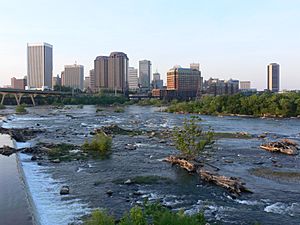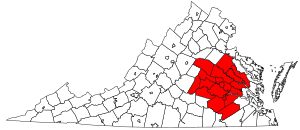Greater Richmond Region facts for kids
Quick facts for kids
Richmond-Petersburg
|
|
|---|---|
| Richmond, VA Metropolitan Statistical Area | |

Richmond, the core city of the Greater Richmond Area
|
|

Counties of the Richmond Metropolitan Statistical Area
|
|
| Country | United States |
| Largest city | Richmond |
| Other cities | |
| Area | |
| • Total | 4,367 sq mi (11,310 km2) |
| Population | |
| • Total | 1,314,434 |
| • Rank | 44th-largest in the U.S. |
| GDP | |
| • MSA | $93.615 billion (2022) |
The Greater Richmond Region is a large area in the middle of Virginia, a state in the United States. It is also called the Richmond metropolitan area or Central Virginia. This region is centered around the city of Richmond.
The U.S. government officially calls this area the Richmond, VA Metropolitan Statistical Area (MSA). This means it's a group of cities and counties that are closely connected. As of 2020, about 1.3 million people lived here. This makes it the 44th largest metropolitan area in the country.
The Greater Richmond Region is special because it sits on the Fall Line. This is where the flat coastal plain meets the hilly Piedmont area. The James River flows through Richmond, and the Appomattox River flows through Petersburg. Both Richmond and Petersburg were important port cities in the 1600s.
Contents
People Living Here
| Historical population | |||
|---|---|---|---|
| Census | Pop. | %± | |
| 1900 | 143,651 | — | |
| 1910 | 172,364 | 20.0% | |
| 1920 | 211,135 | 22.5% | |
| 1930 | 236,957 | 12.2% | |
| 1940 | 262,991 | 11.0% | |
| 1950 | 350,035 | 33.1% | |
| 1960 | 436,044 | 24.6% | |
| 1970 | 518,319 | 18.9% | |
| 1980 | 761,311 | 46.9% | |
| 1990 | 865,640 | 13.7% | |
| 2000 | 1,100,121 | 27.1% | |
| 2010 | 1,188,246 | 8.0% | |
| 2020 | 1,314,434 | 10.6% | |
| Source: | |||
The Richmond Metropolitan Statistical Area (MSA) includes Richmond and three other cities: Petersburg, Hopewell, and Colonial Heights. It also includes several nearby counties. About 1.3 million people live in this area. This is about 15% of all the people in Virginia.
The Richmond region has been growing steadily. In the last 20 years, almost 400,000 new people have moved here. This growth has led to more neighborhoods being built, especially in Henrico and Chesterfield Counties. These counties now have over 300,000 people each.
This growth has also helped the economy. More malls have been built, and Richmond has gained more national attention. Big sporting events and concerts now come to the city. The arts and culture scene has also improved. Many theaters, like the Landmark Theater and Carpenter Center, have been updated. There's also a popular "First Fridays Art Walk" in Downtown Richmond. It happens on the first Friday of every month and attracts over 20,000 people!
The population of Richmond city itself has changed over time. It dropped below 200,000 people for a while but grew back to 204,000 by 2008. The region is located roughly in the middle of Virginia. It's about the same distance from Northern Virginia, Hampton Roads, and Lynchburg.
In 2004, there were about 397,000 homes in the Richmond/Petersburg area. The average household had 2.6 people. Most adults (85%) had finished high school. About 33% had a college degree or higher.
| County | 2021 Estimate | 2020 Census | Change | Area | Density |
|---|---|---|---|---|---|
| Chesterfield County | 370,688 | 364,548 | +1.68% | 423 sq mi (1,100 km2) | 876/sq mi (338/km2) |
| Henrico County | 333,554 | 334,389 | −0.25% | 237.65 sq mi (615.5 km2) | 1,404/sq mi (542/km2) |
| Richmond City | 226,604 | 226,610 | 0.00% | 59.92 sq mi (155.2 km2) | 3,782/sq mi (1,460/km2) |
| Hanover County | 111,603 | 109,979 | +1.48% | 469 sq mi (1,210 km2) | 238/sq mi (92/km2) |
| Prince George County | 42,880 | 43,010 | −0.30% | 265 sq mi (690 km2) | 162/sq mi (63/km2) |
| Petersburg City | 33,429 | 33,458 | −0.09% | 22.72 sq mi (58.8 km2) | 1,471/sq mi (568/km2) |
| Powhatan County | 31,136 | 30,033 | +3.67% | 260 sq mi (670 km2) | 120/sq mi (46/km2) |
| Dinwiddie County | 27,912 | 27,947 | −0.13% | 504 sq mi (1,310 km2) | 55/sq mi (21/km2) |
| Goochland County | 25,488 | 24,727 | +3.08% | 281 sq mi (730 km2) | 91/sq mi (35/km2) |
| New Kent County | 23,897 | 22,945 | +4.15% | 210 sq mi (540 km2) | 114/sq mi (44/km2) |
| Hopewell City | 23,140 | 23,033 | +0.46% | 10.35 sq mi (26.8 km2) | 2,236/sq mi (863/km2) |
| Colonial Heights City | 18,273 | 18,170 | +0.57% | 7.52 sq mi (19.5 km2) | 2,430/sq mi (940/km2) |
| King William County | 18,171 | 17,810 | +2.03% | 274 sq mi (710 km2) | 66/sq mi (25/km2) |
| Amelia County | 13,268 | 13,265 | +0.02% | 355 sq mi (920 km2) | 37/sq mi (14/km2) |
| Sussex County | 10,763 | 10,829 | −0.61% | 490 sq mi (1,300 km2) | 22/sq mi (8.5/km2) |
| King and Queen County | 6,662 | 6,608 | +0.82% | 315 sq mi (820 km2) | 21/sq mi (8.1/km2) |
| Charles City County | 6,594 | 6,773 | −2.64% | 183 sq mi (470 km2) | 36/sq mi (14/km2) |
| Total | 1,324,062 | 1,314,134 | +0.76% | 4,367.16 sq mi (11,310.9 km2) | 302/sq mi (117/km2) |
Getting Around: Transportation
Highways and Expressways
Many important highways cross through the Richmond area. These include Interstate 64 (which goes east-west) and Interstate Highways 85 and 95 (which go north-south). There are also many bypasses and smaller expressways. Some of these roads used to have tolls, but most tolls have been removed. For example, the Richmond-Petersburg Turnpike, which opened in 1958, is now part of I-95 and I-85. I-295 opened in 1992. It helps drivers go around Richmond and Petersburg to the east.
Trains and Railways
The Richmond-Petersburg area is also a hub for train lines. Companies like CSX Transportation and Norfolk Southern Railway operate freight trains here. There are four passenger train stations served by Amtrak:
- Main Street Station in downtown Richmond
- Staples Mill Road Station in Henrico County
- Petersburg Station in Ettrick
- Ashland Station in downtown Ashland
Virginia is also looking into extending high-speed passenger train service. This would connect Richmond to areas like the Virginia Peninsula and South Hampton Roads. There are also plans for a "Transdominion Express" project. This would connect Richmond to cities like Lynchburg and Roanoke to the west.
Ports and Airports
The Port of Richmond has an international deepwater terminal. This means large ships can travel on the James River from here all the way to Hampton Roads, the Chesapeake Bay, and the Atlantic Ocean.
Richmond International Airport is located in Henrico County, just five miles east of Richmond's city center. It has flights to many cities in the Midwest, South, and Northeast of the U.S. In the past, it also had flights to other countries like Canada and Mexico. Recently, the airport has grown a lot. It has added direct flights to major cities like San Francisco, Las Vegas, and Los Angeles.
Economy and Jobs
The Richmond-Petersburg area has a strong and varied economy. About 677,000 people work here. The main types of jobs are in:
- Services (like healthcare, education, and hospitality)
- Retail trade (stores and shops)
- Manufacturing (making products like tobacco, chemicals, paper, and wood items)
- State government
- Finance, insurance, and real estate
- Local government
- Construction
- Wholesale trade (selling goods in large amounts)
- Transportation and public utilities
- Federal government
Having so many different types of jobs helps the region stay strong. If one part of the economy slows down, other parts can help keep things stable. The central location of the region also helps it benefit from growth in other parts of Virginia.
Community Development
Many groups work to improve the economy and community in the Greater Richmond area. The Greater Richmond Partnership is one example. It brings together local government leaders and business leaders. They work together to help the economy grow.
The Community Foundation for a greater Richmond is a non-profit organization. It is one of the largest community foundations in the country. It helps many different projects by giving out grants. It also supports over 60 scholarship programs for students.
See also
 In Spanish: Área metropolitana de Richmond–Petersburg para niños
In Spanish: Área metropolitana de Richmond–Petersburg para niños

